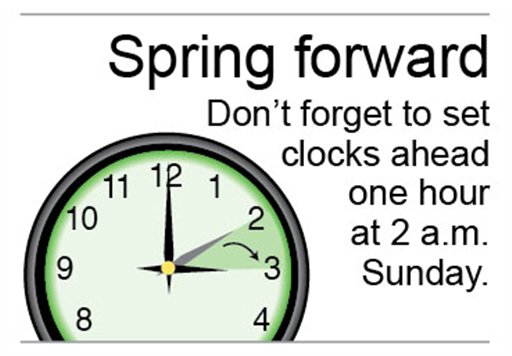Just a friendly reminder: don’t forget to adjust your clocks (if they don’t change automatically) when you head to bed tonight. It’s time to spring forward 1 hour for Daylight Saving Time. Otherwise, you’ll likely arrive an hour late for church or any other appointments or activities you have scheduled Sunday.
Those who are not at their best first thing in the morning might consider going to be an hour or so earlier Saturday night to make up for the hour of sleep lost springing forward tonight.
While most change the time before turning in for the night, the official time change for most of the United States will take place at 2 a.m. local time Sunday, March 13, 2022.

If you’re in the US, (with only a two exceptions) DST begins on the second Sunday in March and ends on the first Sunday in November. In other words, time officially advances forward one hour from 2 a.m. to 3 a.m. local time on the second Sunday in March and then during late fall, goes back fan hour from 2 a.m. to 1 a.m. on the first Sunday in November.
Texas and most of the central part of the US is located in the Central Time Zone. The East Coast will change their clocks an hour before we do, and California and the West Coast will spring forward two hours after we do.
While you lose an hour of sleep tonight, you’ll be gaining an hour of daylight starting Sunday, allowing people to take advantage of the natural daylight, especially for outdoor activities. The main impetus for DST first being enacted was to save energy.
Some believe, based on studies, that the extra hour of daylight could be beneficial in reducing the number of road accidents and injuries during the hours more people use the roads. The Transportation Department touts DST as a means to reduce crime, as more people tend to be out and about during daylight hours as opposed to night time. Others claim changing time messes with circadian rhythms and therefore sleep patterns, which could contribute to more crashes and workplace injuries due to tiredness.
Approximately 40% of the (more than 70) countries in the world observe Daylight Saving Time, moving their clocks forward to take advantage of the natural light. Whether you are on DST or Standard time depends on which hemisphere you are in, as the seasons in the Southern Hemisphere are opposite those in the Northern Hemisphere, and the date varies by and within countries.
DST began in the USA in 1918. The current federal policy – the Uniform Time Act, has been in effect since 1966. While beginning and end dates have varied by a few weeks, the current time change dates have remained firm since the Energy Policy Act of 2005 was enacted, with the US Department of Transportation designated to oversee DST and US time zones.
In the US and Canada, DST will begin on March 13, 2022. However, most states at one time or another have proposed do away with the twice yearly time change, to remain on DST all year in the US.
In fact, according to the National Conference of State Legislatures, more than 350 Daylight Saving Time-related bills and resolutions have been introduced in virtually every state since 2015. But, non of significance passed until 2018, when Florida became the first state to enact legislation to permanently observe DST. Since then, 18 states have enacted legislation or passed resolutions to try to do away with biannual time changes, each proposing either DST or Standard Time be observed year-round. However, Congress must change the law which does not currently allow full DST before states can adopt those proposed changes. Legislative action still pending on the issue.
This year alone, according to the NCSL, 68 pieces of legislation, counting carry over bills from 2021, have been submitted for consideration in at least 28 US states; Texas was not one of them in 2022. However, Texas was one of 33 states in which legislation addressing DST was proposed in 2021. In fact, of the 80 pieces of legislation filed in 2021, nearly a dozen documents were submitted to Texas Senate and House combined; but all 11 failed in Texas..
Two states — Arizona and Hawaii — and the U.S. territories of American Samoa, Guam, the Northern Mariana Islands, Puerto Rico, and the Virgin Islands observe permanent standard time, NCSL reports. The Navajo Nation, which falls within more than one state and/or time zone is the exception for Arizona.
In Europe, however, DST won’t take place until March 27, 2022. Australia, New Zealand, most of South America and Southern Africa observed observe DST beginning in either September or November through March or April, when Standard Time begins.
Regardless your stance on DSL, local emergency responders remind the time change is good time to make biannual batteries changes in smoke detectors and carbon monoxide alarms to test to ensure these potentially life-saving devices in your homes functioning properly.






